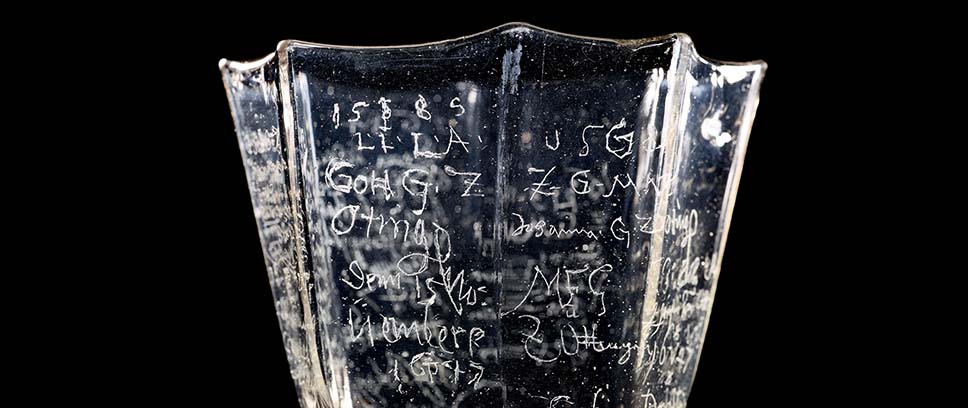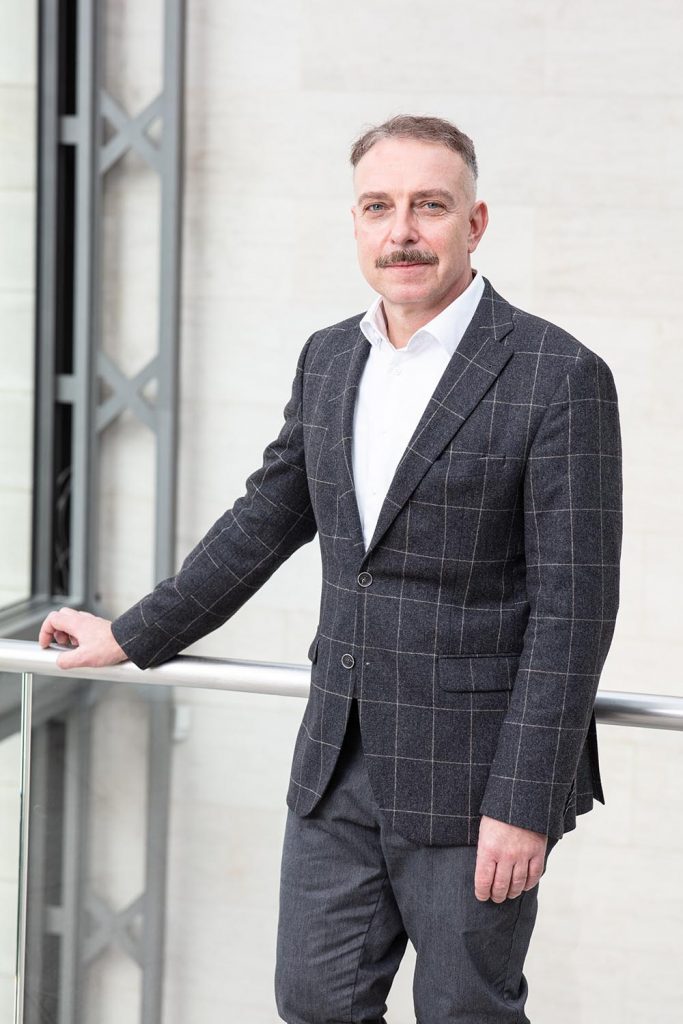
A “Guest Book Made of Glass”: The ‘Welcome’ Beaker of the Princes of Oettingen-Wallerstein
Wolfgang Cortjaens | 3 August 2022
The Deutsches Historisches Museum recently had the good fortune of acquiring a Willkomm (welcome) beaker of the Princes of Oettingen-Wallerstein. Wolfgang Cortjaens, head of Applied Arts and Graphics, sheds light on the rare object and its significance.
After wandering through the museum, it is often the small, “quirky” objects that stick in visitors’ minds. And if experience is anything to go by, the latest accession to the Collection of Applied Art – the “Oettingen Willkomm” – will quickly shoot to the top of that list of favourite “quirks”. The purchase of this extremely rare piece, generously made possible by the Museumsverein of the DHM and the Kulturstiftung der Länder, represents something of a coup that might be easily overlooked by the untrained eye. At first glance, the glassware item in question is a plain, not even particularly finely worked drinking glass dating from the Renaissance period. The production of such glass vessels dates back to the Late Middle Ages, but the first recorded use of the term Willkomm to describe them stems from the 16th century and reflects their original use: Willkomm beakers or goblets were usually large, ornately decorated drinking vessels made of a combination of fine materials. The word Willkomm refers to the custom of presenting a ‘welcoming’ drink to a guest of honour upon arrival at a festive occasion, such as the feast of a nobleman, a courtly tournament, or a guild meeting. This is one such object, even though in shape, design, and choice of material it does not look especially sophisticated. Far more fascinating than its unusual, octagonal fluted design, however, is its surface, which is completely covered in engraved inscriptions. Over a period of 100 years, a total of 32, often high-ranking guests, including generals, noblemen, and notable members of the clergy, used a diamond point to score their names into the glass, often including their titles, and sometimes an epigram and the year. This makes the object one of the few surviving Willkomm glasses in the world to have been marked as part of a courtly ceremonial. Such glasses are extremely rare, with just a dozen or so in existence, and the Oettingen Willkomm is the oldest known example of its kind.

The DHM was notified that the beaker was available for purchase on the art market after it had been in the Oettingen-Wallerstein family’s possession for over 500 years. The Oettingen were a family of Franconian-Swabian nobles whose territory, the county of Oettingen im Riesgau, was made a principality in 1674, from where they also ruled over the county towns of Nördlingen and Dillingen on the Danube. The territory was a much-contested area during the wars unleashed by the Reformation in the 16th and 17th century, and this is indirectly reflected by the small glass itself: The earliest name on it dates from 1548 and is the Reformer Georg Karg (“Parsimonius”, c. 1512–1576), who in 1539 was appointed court chaplain in Oettingen upon Martin Luther’s recommendation, but then fled to Schwabach after a conflict. The names and epigrams of members of the (predominantly) Protestant high nobility in southern Germany follow in irregular succession. Indeed, one merely states his name as “böser Bub” (bad boy), leaving his identity a mystery. The two most frequently named dates are 1634 and 1647, and this most probably relates to two events in the Thirty Years’ War: the 1634 Battle of Nördlingen (ending Swedish domination in southern Germany) and the Truce of Ulm of 1647.
In the case of the Oettingen Willkomm, it was precisely the vessel’s apparent simplicity and the conspicuous lack of symmetry in its markings that added to its importance. Its value did not lie in the object itself but rather in the privilege of being allowed to engrave one’s name on it, as a sign of “having been a guest in the house of Oettingen, having drunk from the glass, which of course placed one in a certain tradition,” as Dr. Dedo Korssenbrock-Krosigk of the Glasmuseum Hentrich, Düsseldorf writes. Before financing the purchase, the Kulturstiftung der Länder requested that Kerssenbrock-Krosigk deliver an expert opinion on the object. In it, he aptly states: “By inviting certain eminent figures to drink from this very glass and immortalize themselves on its surface, its value steadily increased over time.” It was probably not until long after it was last put to use as a ceremonial Willkomm, in 1650, that the non-original silver base was added to its bottom, probably to emphasize the special significance of this heirloom.

Similar noteworthy items are preserved in the Corning Museum of Glass, in the state of New York, as well as other museum collections. One notable example is the Van Geuzen Schaaltje in Amsterdam’s Rijksmuseum, with inscriptions carved between 1573 and 1591 by six Calvinist leaders of the revolt against the Spanish Crown. Meanwhile, a decidedly political message is contained in the Jacobite “Amen” glasses, of which many examples survive in different museum collections. The inscriptions on these glasses pay homage, sometimes openly, sometimes in coded terms, to the Catholic Stuart king James II (expelled from England in the so-called Glorious Revolution of 1688) and, in some cases, his descendants. As with the Oettingen Willkomm, the true significance of these similar objects would only have been appreciated by a narrow circle of confidantes allowed to use them.
In the next permanent exhibition of the DHM, the Oettingen Willkomm will go on view to illustrate several aspects of history at once: the (vanished) customs of hospitality and courtly culture in the early modern period, and as a record of the history of the Reformation with both local and European significance. As head of the collection, I would like to take this opportunity to express my sincere thanks to the Museumsverein of the DHM and the Kulturstiftung der Länder for making the acquisition of this unique museum piece possible.
|
© DHM/Thomas Bruns |
Wolfgang CortjaensWolfgang Cortjaens is Head of Applied Arts and Graphics at Deutschen Historischen Museum. |
